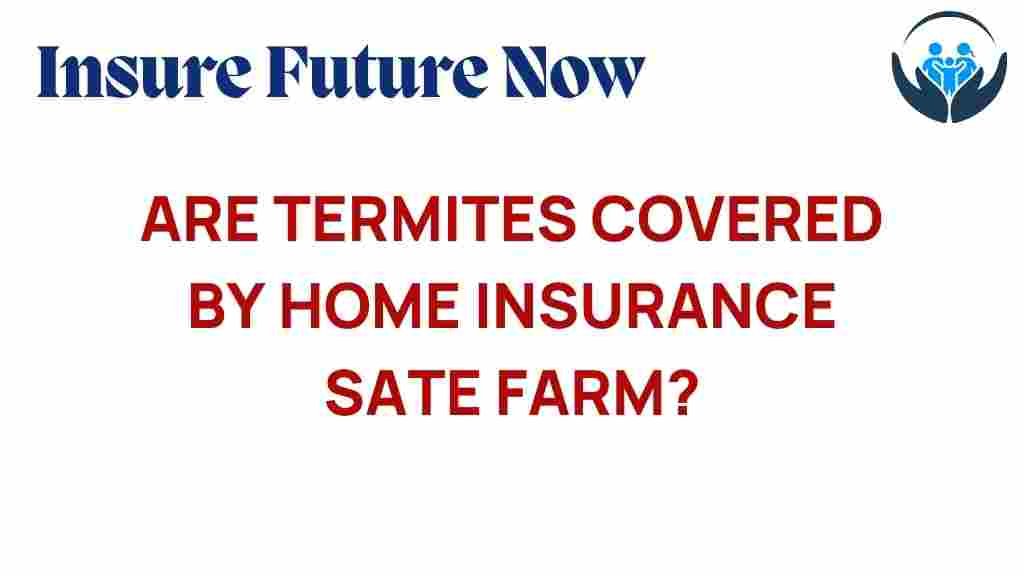Are Termites Covered by Home Insurance?
Homeowners frequently face a myriad of concerns regarding the safety and integrity of their properties. Among these concerns, termites pose a significant threat to homes. As one of the most destructive pests, termites can cause extensive damage, leading many to wonder: are termites covered by home insurance? In this article, we will unveil the truth about termite coverage in home insurance policies, focusing on the key aspects such as coverage, exclusions, and how different insurers, including State Farm, handle pest damage.
Understanding Home Insurance Coverage
Home insurance is designed to protect homeowners from financial losses related to various risks, including theft, fire, and natural disasters. However, not all damages are covered equally. Understanding the nuances of your policy is crucial in determining whether termite damage is included in your home insurance coverage.
What Types of Damage Does Home Insurance Typically Cover?
Most standard home insurance policies cover:
- Damage from fire or lightning
- Theft and vandalism
- Wind and hail damage
- Water damage (from certain sources)
- Liability for injuries that occur on your property
While these are common inclusions, termite damage often falls into a different category that may not be covered.
Termites and Home Insurance Policies
When it comes to termites, the answer is often not straightforward. Most standard home insurance policies do not cover damage caused by pests, including termites. This exclusion is a critical detail that homeowners need to be aware of when considering home protection.
Why Are Termites Excluded from Coverage?
Insurance companies typically exclude pest damage for several reasons:
- Preventable Nature: Termite infestations are often seen as preventable through regular maintenance and inspections.
- Gradual Damage: Termites cause damage over time rather than in a single event, making it challenging to assess the financial impact.
- Policy Limitations: Home insurance is designed to cover sudden and unforeseen events, while termite damage is generally considered a maintenance issue.
State Farm and Termite Coverage
One of the most prominent insurance providers in the United States, State Farm offers various home insurance policies. However, like many insurers, State Farm typically excludes termite damage from its standard coverage. It’s essential to review your specific policy details to understand what is and isn’t covered.
What to Look for in Your State Farm Policy
When reviewing your policy, pay attention to:
- Exclusion Clauses: Look for specific clauses that mention pest damage or exclusions related to termites.
- Optional Endorsements: Inquire about any additional coverage options that may be available for pest control or damage.
- Home Maintenance Requirements: Some policies may require regular inspections as a condition for coverage.
Dealing with Termite Damage: A Step-by-Step Process
If you discover a termite infestation in your home, follow these steps to address the issue:
Step 1: Identify the Infestation
Look for signs of termite activity, such as:
- Discarded wings near windows or doors
- Tubular mud structures along walls or foundations
- Hollow-sounding wood when tapped
Step 2: Contact a Pest Control Professional
Once you suspect termite damage, it’s crucial to contact a pest control expert. They can assess the situation and provide treatment options.
Step 3: Document the Damage
Take photographs and notes of the damage for your records. This documentation might be helpful if you decide to file a claim for other covered damages related to the infestation.
Step 4: Review Your Home Insurance Policy
Check your policy for any references to pest damage. Understanding your coverage will help you prepare for any potential out-of-pocket costs.
Claims and Exclusions Related to Termites
When it comes to filing a claim, it’s essential to know the exclusions that apply to termite damage. Most home insurance policies will not cover:
- Damage caused by termites and other pests
- Costs associated with pest control services
- Preventative treatments or repairs
If you have incurred damage from a covered event that may have been exacerbated by termites, you should still document the situation and reach out to your insurer. However, be prepared for the possibility that your claim may be denied based on the policy exclusions.
Tips for Homeowners: Preventing Termite Infestations
Preventing termite infestations is the best way to safeguard your home. Here are some effective strategies:
- Regular Inspections: Schedule annual inspections with a pest control professional.
- Moisture Control: Ensure proper drainage around your home and fix any leaks.
- Wood Maintenance: Store firewood away from the house and use treated wood in construction.
- Seal Entry Points: Close off any cracks or openings in the foundation and walls.
Consider Optional Coverage
Some insurers offer optional pest damage endorsements that can provide coverage for termite damage. Speak with your insurance agent about available options that suit your needs.
What to Do if You Experience Termite Damage
If you discover termite damage in your home, take the following actions:
- Contact a Professional: Get a licensed pest control expert to evaluate and treat the infestation.
- Document Everything: Keep records of all communications, treatments, and damages.
- Communicate with Your Insurer: Even if termite damage isn’t covered, keep your insurance company informed about other potential damages.
Conclusion
In summary, termites are generally not covered by standard home insurance policies, including those from State Farm. Homeowners need to understand the policy details, including exclusions related to pest damage. Taking proactive steps in prevention and maintenance can significantly reduce the risk of infestations. Always consult your insurance provider to clarify any uncertainties regarding your specific coverage and consider optional endorsements for added peace of mind.
For more information on home insurance policies, consider visiting State Farm’s official website. If you’re looking for pest control services, check out local pest control options in your area.
This article is in the category Coverage and created by InsureFutureNow Team
